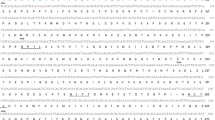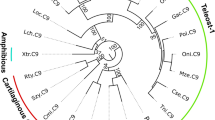Abstract
The complement component C5 plays important roles in inflammatory responses and complement-mediated cytolysis. In bony fish, although C5 has been identified at the DNA or the protein level in trout, carp and gilthead seabream, only partial C5 sequences are available. The present study was designed to obtain the complete primary structure of C5 from the common carp (Cyprinus carpio) and to examine its possible structural diversity. Reverse-transcribed polymerase chain reaction amplification from carp hepatopancreatic RNA resulted in isolation of six distinct C5-like cDNA segments, which were grouped into two divergent types (type I and type II). Using two sequences representative of the two types as probes, two distinct full-length cDNA clones (C5-1 and C5-2) were isolated, in addition to a truncated isoform of C5-1 (C5-1′). The deduced amino acid sequences of C5-1 and C5-2 share 83% identity and predict a typical two-chain structure of the mature protein that lacks the thioester bond, as in C5 from other animals. Southern hybridization of genomic DNA suggested the presence of multiple genes encoding C5-type I and a single gene encoding C5-type II. Interestingly, carp C5-type I contains novel subtypes like C5-1 that have a histidine instead of the well-conserved arginine at the cleavage site for the C5 convertase, both in the complete and truncated forms. Northern blotting analysis suggested that C5-type I and C5-type II are mainly expressed in hepatopancreas, and the expression levels are significantly increased by stimulating carp with lipopolysaccharide or β-1,3-glucan. Possible functional divergence among the C5 isotypes in carp is discussed.






Similar content being viewed by others
References
Bubeck P, Grötzinger J, Winkler M, Köhl J, Wollmer A, Klos A, Bautsch W (1994) Site-specific mutagenesis of residues in the human C5a anaphylatoxin which are involved in possible interaction with the C5a receptor. Eur J Biochem 219:897–904
Chomczynski P (1993) A reagent for the single-step simultaneous isolation of RNA, DNA and proteins from cell and tissue samples. BioTechniques 15:532–534
Franchini S, Zarkadis IK, Sfyroera G, Sahu A, Moore WT, Mastellos D, LaPatra SE, Lambris JD (2001) Cloning and purification of the rainbow trout fifth component of complement (C5). Dev Comp Immunol 25:419–430
Hughes AL (1994) Phylogeny of the C3/C4/C5 complement-component gene family indicates that C5 diverged first. Mol Biol Evol 11:417–425
Jeanmougih F, Thompson JD, Gouy M, Higgins DG, Gibson TJ (1998) Multiple sequence alignment with Clustal X. Trends Biochem Sci 23:403–405
Kasahara M (1998) What do the paralogous regions in the genome tell us about the origin of the adaptive immune system? Immunol Rev 166:159–175
Kola A, Baensch M, Bautsch W, Klos A, Köhl J (1999) Analysis of the C5a anaphylatoxin core domain using a C5a phage library selected on differentiated U937 cells. Mol Immunol 36:145–152
Law SKA, Reid KBM (1995) Complement. In: Male D (ed) Complement, 2nd edn. IRL Press, Oxford
Mollison KW, Mandecki W, Zuiderweg ER, Fayer L, Fey TA, Krause RA, Conway RG, Miller L, Edalji RP, Shallcross MA, Lane B, Fox JL, Greer J, Carter GW (1989) Identification of receptor-binding residues in the inflammatory complement protein C5a by site-directed mutagenesis. Proc Natl Acad Sci U S A 86:292–296
Mutsuro J, Nakao M, Fujiki K, Yano T (2000) Multiple forms of α2-macroglobulin from a bony fish, the common carp (Cyprinus carpio): striking sequence diversity in functional sites. Immunogenetics 51:847–855
Nakao M, Uemura T, Yano T (1996) Terminal components of carp complement constituting a membrane attack complex. Mol Immunol 33:933–937
Nakao M, Fushitani Y, Fujiki K, Nonaka M, Yano T (1998) Two diverged complement factor B/C2-like cDNA sequence from a teleost, the common carp (Cyprinus carpio). J Immunol 161:4811–4818
Nakao M, Mutsuro J, Obo R, Fujiki K, Nonaka M, Yano T (2000) Molecular cloning and protein analysis of divergent forms of the complement component C3 from a bony fish, the common carp (Cyprinus carpio): presence of variants lacking the catalytic histidine. Eur J Immunol 30:858–866
Nakao M, Matsumoto M, Nakazawa M, Fujiki K, Yano T (2002) Diversity of complement factor B/C2 in the common carp (Cyprinus carpio): three isotypes of B/C2-A expressed in different tissues. Dev Comp Immunol 26:533–541
Nilsson UR, Mandle RJ, McConnell-Mapes JA (1975) Human C3 and C5: subunit structure and modification by trypsin and C42-C423. J Immunol 114:815–822
Nonaka M, Takahashi M (1992) Complete complementary DNA sequence of the third component of complement of lamprey. Implication for the evolution of thioester containing proteins. J Immunol 148:3290–3295
Nonaka M, Natsuume-Sakai S, Takahashi M (1981) The complement system in rainbow trout (Salmo gairdneri). J Immunol 126:1495–1498
Ohno S (1970) Evolution by gene duplication. Springer, Berlin Heidelberg New York
Saitou N, Nei M (1987) The neighbor-joining method: a new method for reconstructing phylogenetic trees. Mol Biol Evol 4:406–425
Sambrook J, Fritsch EF, Maniatis T (1989) Molecular cloning: a laboratory manual, 2nd edn. Cold Spring Harbor Laboratory Press, Cold Spring Harbor, NY
Sanger F, Nicklen S, Coulson AR (1977) DNA sequencing with chain-terminating inhibitors. Proc Natl Acad Sci USA 74:5463–5467
Sunyer JO, Tort L, Lambris JD (1997) Structural C3 diversity in fish: characterization of five forms of C3 in the diploid fish Sparus aurata. J Immunol 158:2813–2821
Tack BF, Morris SC, Prahl JW (1979) Fifth component of human complement: purification from plasma and polypeptide chain structure. Biochemistry 18:1490–1497
Toth MJ, Huwyler L, Boyar WC, Braunwalder AF, Yarwood D, Hadala J, Haston WO, Sills MA, Seligmann B, Galakatos N (1994) The pharmacophore of the human C5a anaphylatoxin. Protein Sci 3:1159–1168
Yano T, Matsuyama H, Mangindaan REP (1991) Polysaccharide-induced protection of carp, Cyprinus carpio L., against bacterial infection. J Fish Dis 14:577–582
Zhang X, Boyar W, Toth MJ, Wennogle L, Gonnella NC (1997) Structural definition of the C5a terminus by two-dimensional nuclear magnetic resonance spectroscopy. Proteins 28:261–267
Zwirner J, Fayyazi A, Götze O (1999) Expression of the anaphylatoxin C5a receptor in non-myeloid cells. Mol Immunol 36:877–884
Acknowledgements
We are grateful to Dr. C. J. Bayne, Oregon State University, for critically reading the manuscript. This study was supported in part by a grant-in-aid for scientific research from the Ministry of Education, Science, Sports and Culture, Japan, 11460098 to Y.T. and 12660173 to M.N.
Author information
Authors and Affiliations
Corresponding author
Additional information
The nucleotide sequence data reported in this paper have been submitted to the DDBJ, EMBL, and GenBank nucleotide sequence databases and have been assigned the following accession numbers: AB084635 for C5-1, AB094587 for C5-1′ and AB084636 for C5-2.
Rights and permissions
About this article
Cite this article
Kato, Y., Nakao, M., Mutsuro, J. et al. The complement component C5 of the common carp (Cyprinus carpio): cDNA cloning of two distinct isotypes that differ in a functional site. Immunogenetics 54, 807–815 (2003). https://doi.org/10.1007/s00251-002-0528-7
Received:
Revised:
Published:
Issue Date:
DOI: https://doi.org/10.1007/s00251-002-0528-7




